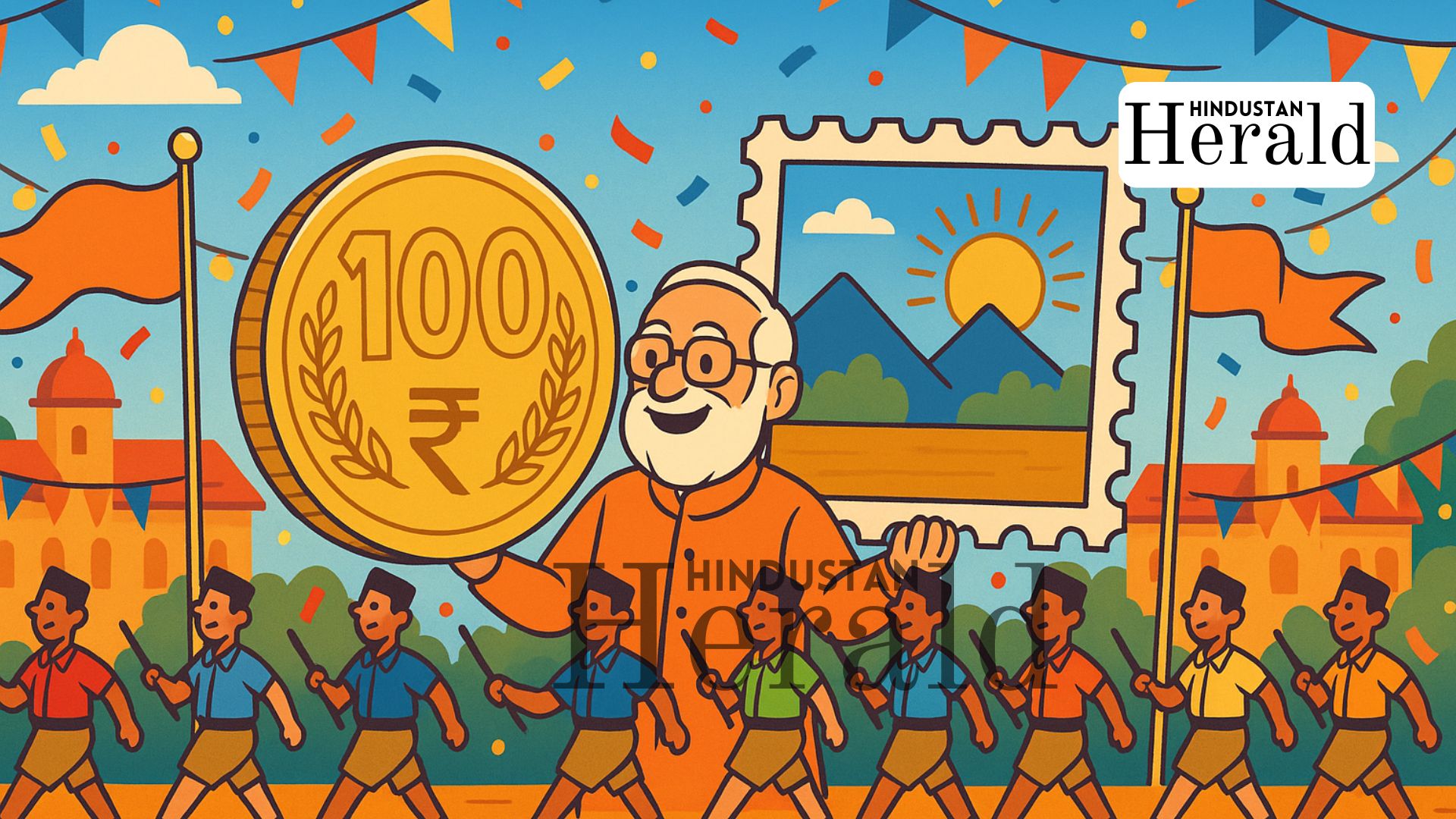New Delhi, October 1: On Tuesday afternoon, under the gilded lighting of a packed hall, Prime Minister Narendra Modi held up a ₹100 coin embossed with the image of Bharat Mata. The applause was instant, almost rehearsed. A postage stamp followed, carrying the same motif. Modi called it a tribute to a century of the Rashtriya Swayamsevak Sangh (RSS), the organisation that began with a modest shakha in Nagpur in 1925 and has since grown into a machine that touches everything from politics to education to disaster relief.
But the ceremony was never just about coins and stamps. It was about symbolism who gets to write India’s story, and whose memory is etched into state-sanctioned iconography. “Sacrifice, service, discipline,” Modi said, summing up the RSS’s 100 years. His words were calculated, but they also marked how far the Sangh has travelled from being dismissed as an ideological fringe to being celebrated by the highest office in the land.
A Classroom Called “Rashtraneeti”
If Modi’s gesture was about history books, the Delhi government’s new move is about the future. The city’s schools are set to introduce a full-fledged subject titled “Rashtraneeti”. From Class 1 to 12, students will study freedom fighters alongside lessons on the RSS.
For supporters, it is about balance: why should Gandhi, Nehru, and Patel dominate the syllabus while Hedgewar or Golwalkar remain footnotes? For critics, it feels like indoctrination. “It’s one thing to mention the RSS, quite another to place it on the same pedestal as Gandhi or Subhas Chandra Bose,” said a senior educationist in Delhi. Parents are divided too, some welcoming the inclusion, others uneasy at what they see as political storytelling wearing the garb of pedagogy.
This tension isn’t new, but in classrooms, the stakes are sharper. What children read at age ten often sticks longer than what they read at thirty.
A Push For Recognition
The centenary has also reignited an old demand: official honours for the Sangh’s founder. Jamal Siddiqui, a BJP leader and one of the party’s few Muslim faces, has written to the President seeking a Bharat Ratna for K. B. Hedgewar. His reasoning is simpl: Hedgewar participated in the freedom struggle, and history has underplayed it.
Yet the call is political to its core. Awarding Hedgewar the Bharat Ratna would mean rewriting India’s nationalist hierarchy. It would mean placing him alongside Nehru and Patel, even as many historians insist the RSS stayed on the sidelines during critical moments like the Quit India movement of 1942.
Marches And Mass Contact
Meanwhile, on the ground, the Sangh is doing what it knows best: mobilising. Across Uttar Pradesh, swayamsevaks will march on October 2, Gandhi’s birthday. The optics are not lost on anyone. An organisation forever linked, fairly or not, with Gandhi’s assassination, now walking in his name-day parades, is as provocative as it is symbolic.
Nationwide, more than 1.03 lakh gatherings are planned this year. Former President Ram Nath Kovind will share a stage in Nagpur. Dr. Kamaltai Gavai, the mother of Chief Justice B. R. Gavai, has been invited to Amravati. It’s no longer just party workers or grassroots volunteers turning up. The Sangh is deliberately widening its circle of recognition.
“Families of volunteers are as important as the volunteers themselves,” declared Dattatreya Hosabale, the organisation’s general secretary. His words hint at strategy. The RSS wants not just swayamsevaks in khaki shorts it wants their wives, children, and neighbours to become part of the fold.
Between Reverence And Resistance
None of this is without controversy. For supporters, the centenary is a moment of vindication: after decades of bans and suspicion, the Sangh stands tall, mainstream, and unashamed. For critics, it is the culmination of a long project to fold the state itself into a Hindu nationalist vision.
The decision to hold mass marches on Gandhi Jayanti, the push for a Bharat Ratna for Hedgewar, the rewriting of school syllabi each is both celebration and provocation. One side sees homage; the other sees a quiet rewriting of what India is supposed to mean.
Internationally, too, observers are watching closely. For decades, India projected itself as plural, secular, and multi-faith. Now, with the RSS’s centenary taking centre stage, questions are being asked about what kind of India the world will be dealing with in 2047, when the Republic turns 100.
The Road Ahead
Anniversaries, by design, are about memory. But this one is also about power. The RSS is not looking back so much as laying claim to the century ahead.
From shakhas in playgrounds to stamps in government halls, the Sangh has managed to embed itself everywhere. The centenary celebrations are not just about where the RSS has been. They are about where it believes India should go next.
Whether that vision unites or divides will depend on how much room India’s democracy allows for dissenting voices. For now, though, the Sangh is walking through the streets with the confidence of an organisation that believes history has finally bent in its direction.
Stay ahead with Hindustan Herald — bringing you trusted news, sharp analysis, and stories that matter across Politics, Business, Technology, Sports, Entertainment, Lifestyle, and more.
Connect with us on Facebook, Instagram, X (Twitter), LinkedIn, YouTube, and join our Telegram community @hindustanherald for real-time updates.
Covers Indian politics, governance, and policy developments with over a decade of experience in political reporting.






